User Tag List
Results 46 to 56 of 56
-
10-20-2021, 04:47 PM #46
Certainly all in for the self medicating ( doing that now with a nice pitcher of lager ), other than that, your right, we need to weather the storm. One thing WE as a HIGH SPEED BOATING COMMUNITY can do is ignore these leftards and village idiots who insist on posting about little electric boats.....nothing fast or impressive about any of it. These dopes will eventually bring their regurgitated battery crap to an all electric site and leave the high speed stuff to those of us that are still involved
1977 Hydrostream Vector 2.5 Promax
-
 David - WI liked this post
David - WI liked this post
-
10-20-2021, 04:48 PM #47
Can we just ban California
Check out my onlyfans....
Subscriptions start at 1 gallon 100LL a month
-
-
10-20-2021, 05:05 PM #48
Bud called me yesterday to go for a ride on the motorcycles, so I just had to take off early. Headed up to Dana point for some fish n chips, and a couple Racer 5's. Then over to Ortega hwy, Palomar mtn, stop in Julian, then over to Laguna mtn, and back home. What a day, California dreamin...

You guys should try being happy instead of pissing and moaning aboot lawn mowers in a state you don't even live in. The world is a changin bros, whether you like it or not.
-
10-20-2021, 06:01 PM #49
 Supporting Member
Supporting Member
- Join Date
- Apr 2003
- Location
- New Smyrna Beach, FL./LOTO
- Posts
- 6,643
- Thanks (Given)
- 606
- Thanks (Received)
- 922
- Likes (Given)
- 1698
- Likes (Received)
- 7144
- Mentioned
- 3 Post(s)
- Tagged
- 1 Thread(s)
California has some of the most beautiful country that there is. I have been up and down PC hwy on bikes several times, lake Tahoe is incredible, New port and Catalina island are something really special but the leadership that requires a special label on everything for their state is totally out of control. I guess that is part of the reason they are now losing population for the first time-people can only take so much dictatorship before they just bail.
Joe
-
 hydrochicken liked this post
hydrochicken liked this post
-
10-21-2021, 08:17 AM #50
I / we are happy ..

However , even though we choose to not live in wokeafornia much of the insanity that starts there seems to bleed it's way into national rules by way of 3000 page wish list's that "has to be passed to know what it says inside".
If you want to mow your 10 acre's with a little battery made in china, be our guest.
The rest of us would rather try and stop it before we are "forced" to follow the stupidity of the scam.
The world is changing ... really, how ..???
The world ... nope, just the minority of idiots that think we need to follow them off the cliff .. happy landings to you
-
 mragu thanked for this post
mragu thanked for this post
-
10-21-2021, 09:11 PM #51
My neighbor bought an electric riding mower and if he doesn't mow every week, i have to go cut his yard with my gas mower. The lectric jus don't cut it....
-
10-21-2021, 10:36 PM #52
 Screaming And Flying!
Screaming And Flying!
- Join Date
- Jun 2007
- Location
- Singapore/Melbourne/Italy
- Posts
- 9,109
- Thanks (Given)
- 1010
- Thanks (Received)
- 356
- Likes (Given)
- 4327
- Likes (Received)
- 1976
- Mentioned
- 8 Post(s)
- Tagged
- 0 Thread(s)
Doesnt a Prius have a small gas engine?
-
10-22-2021, 06:13 AM #53
I agree with Chaz on this one. The world isnt changing. The only thing changing is the libtard ideals that always start in commiefornia before spreading to the rest of the country. Im not a fan of the "global warming" idea either. Honestly, we dont know chit about it. Everything published about it is nothing more than hypothesis. How long have humans been here? How long have humans been recording history? How much of that recorded history is climate related? How long has the earth been here? Yeah, we dont know chit about our own climate and even less about what causes changes in the patterns. Reminds me of the "carbon dating method" scam that was debunked not long ago.
"The character of a man can be easily judged by how he treats those who can do nothing for him"
-
10-22-2021, 07:41 AM #54
Your wrong on all counts...
<header style="box-sizing: inherit;">Carbon dating, the archaeological workhorse, is getting a major reboot
A long-anticipated recalibration of radiocarbon dating could shift the age of some prehistoric samples hundreds of years
use data from tree rings, sediment layers and other samples to calibrate the process of carbon dating.Credit: Philippe Clement/Arterra/Universal Images Group/Getty</header><figure class="figure" style="margin: 0px 0px 15px; box-sizing: inherit;">
</figure>Radiocarbon dating — a key tool used for determining the age of prehistoric samples — is about to get a major update. For the first time in seven years, the technique is due to be recalibrated using a slew of new data from around the world. The result could have implications for the estimated ages of many finds — such as Siberia’s oldest modern human fossils, which according to the latest calibrations are 1,000 years younger than previously thought.
The work combines thousands of data points from tree rings, lake and ocean sediments, corals and stalagmites, among other features, and extends the time frame for radiocarbon dating back to 55,000 years ago — 5,000 years further than the last calibration update in 2013.
Archaeologists are downright giddy. “Maybe I've been in lockdown too long,” tweeted Nicholas Sutton, an archaeologist at the University of Otago in New Zealand, “but … I'm really excited about it!”
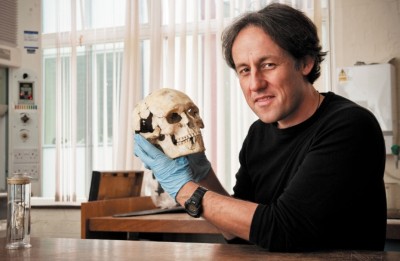 Archaeology: Date with history
Archaeology: Date with history
Although the recalibration mostly results in subtle changes, even tiny tweaks can make a huge difference for archaeologists and paleo-ecologists aiming to pin events to a small window of time. A new calibration curve “is of key importance” for understanding prehistory, says Tom Higham, archaeological chronologist and director of the Oxford Radiocarbon Accelerator Unit, UK.
Dating games
The basis of radiocarbon dating is simple: all living things absorb carbon from the atmosphere and food sources around them, including a certain amount of natural, radioactive carbon-14. When the plant or animal dies, they stop absorbing, but the radioactive carbon that they’ve accumulated continues to decay. Measuring the amount left over gives an estimate as to how long something has been dead.
But this basic calculation assumes that the amount of carbon-14 in the environment has been constant in time and space — which it hasn’t. In recent decades, the burning of fossil fuel and tests of nuclear bombs have radically altered the amount of carbon-14 in the air, and there are non-anthropogenic wobbles going much further back. During planetary magnetic-field reversals, for example, more solar radiation enters the atmosphere, producing more carbon-14. The oceans also suck up carbon — a little more so in the Southern Hemisphere, where there is more ocean — and circulate it for centuries, further complicating things.
As a result, conversion tables are needed that match up calendar dates with radiocarbon dates in different regions. Scientists are releasing new curves for the Northern Hemisphere (IntCal20), Southern Hemisphere (SHCal20), and marine samples (MarineCal20). They will be published in the journal Radiocarbon in the next few months.
Since the 1960s, researchers have mainly done this recalibration with trees, counting annual rings to get calendar dates and matching those with measured radiocarbon dates. The oldest single tree for which this has been done, a bristlecone pine from California, was about 5,000 years old. By matching up the relative widths of rings from one tree to another, including from bogs and historic buildings, the tree record has now been pushed back to 13,910 years ago.
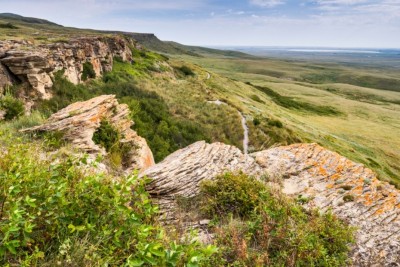 World's largest hoard of carbon dates goes global
World's largest hoard of carbon dates goes global
Since 1998 there have been four official IntCal calibrations, adding in data from laminated lake and marine sediments, cave stalagmites and corals (which can be both radiocarbon dated and independently assessed using techniques such as radioactive thorium/uranium dating). In 2018, some stalagmites in Hulu Cave in China provided a datable record stretching back 54,000 years1.
IntCal20 is based on 12,904 data points, nearly double the size of 2013’s data set. The results are far more satisfying, says Paula Reimer, who heads the IntCal working group and leads the radiocarbon-dating Chrono Centre at Queen’s University Belfast, UK. For a known, brief magnetic field reversal 40,000 years ago, for example, the 2013 curve’s carbon-14 peak was too low and too old by 500 years — an annoyance fixed by the new curve.
Higham says the recalibration is fundamental for understanding the chronology of hominins living 40,000 years ago. “I am really excited about calibrating our latest data using this curve,” he says.
Recalibrate and reassess
IntCal20 revises the date for a Homo sapiens jawbone found in Romania called Oase 1, potentially making it hundreds of years older than previously thought2. Genetic analyses of Oase 1 have revealed that it had a Neanderthal ancestor just four to six generations back, says Higham, so the older the Oase 1 date, the further back Neanderthals were living in Europe. Meanwhile, the oldest H. sapiens fossil found in Eurasia — Ust’-Ishim, unearthed in Siberia — is almost 1,000 years younger according to the new conversion curves. “It changes the earliest date we can place on modern humans in central Siberia,” says Higham. He cautions, however, that there are more sources of error in such measurements than just radiocarbon calibration: “Contamination is the biggest influence for dating really old bones like these.”
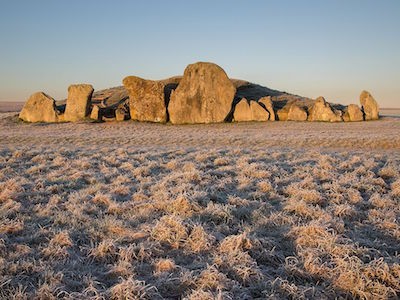 Divided by DNA: The uneasy relationship between archaeology and ancient genomics
Divided by DNA: The uneasy relationship between archaeology and ancient genomics
Others will use the recalibration to assess environmental events. For example, researchers have been arguing for decades over the timing of the Minoan eruption at the Greek island of Santorini. Until now, radiocarbon results typically gave a best date in the low 1600s BC, about 100 years older than given by most archaeological assessments. IntCal20 improves the accuracy of dating but makes the debate more complicated: overall, it bumps the calendar dates for the radiocarbon result about 5–15 years younger, but — because the calibration curve wiggles around a lot — it also provides six potential time windows for the eruption, most likely in the low 1600s BC, but maybe in the high 1500s BC2.
So the two groups still disagree, says Reimer, but less so, and with more complications. “Some of them are still arguing,” says Reimer. “There’s no hard answer.”
Nevertheless, anyone looking at practically anything relating to human history from the past 50,000 years will be enthusiastic about the new calibration, says Higham: “This is a particularly exciting time to be working on the past.”
We have invented the world; WE see
-
10-22-2021, 08:07 AM #55
I'm amazed how many don't believe in Science... I guess It's the anti - education group ?
Back in the mid 70's I transferred to Buffalo State Teachers college and I needed a science class to fulfill my requirements, I found a Archaeology class I soon found out It was a class for Majors in Archaeology I was the only person that was not part of the group, you would not believe how much concentration was given to such a small period of time.
<header class="entry-header clearfix" style="margin: 0px; padding: 0px; border: 0px; font-variant-numeric: inherit; font-variant-east-asian: inherit; font-stretch: inherit; font-size: 16px; line-height: inherit; font-family: "pt serif", Georgia, Times, "times new roman", serif; vertical-align: baseline; color: rgb(0, 0, 0);">Fossil Treasure Trove Shows Complex Social Herd Behavior in Dinosaurs 193 Million Years Ago
TOPICS:ArchaeologyDinosaursMITPaleontology
</header>By JENNIFER CHU, MASSACHUSETTS INSTITUTE OF TECHNOLOGY OCTOBER 21, 2021
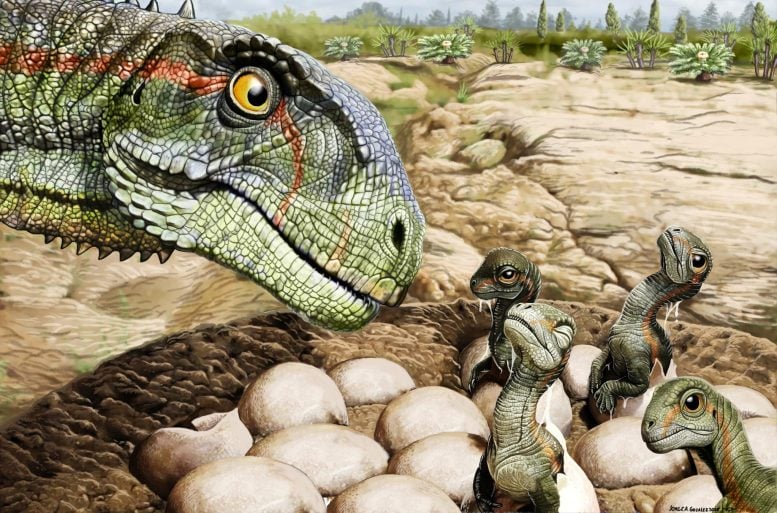 Artistic reconstruction of a Mussaurus patagonicus nest. Credit: Jorge Gonzalez
Artistic reconstruction of a Mussaurus patagonicus nest. Credit: Jorge Gonzalez
Fossils indicate a communal nesting ground and adults who foraged and took care of the young as a herd, scientists say.
To borrow a line from the movie “Jurassic Park:” Dinosaurs do move in herds. And a new study shows that the prehistoric creatures lived in herds much earlier than previously thought.
In a paper appearing today (October 21, 2021) in Scientific Reports, researchers from MIT, Argentina, and South Africa detail their discovery of an exceptionally preserved group of early dinosaurs that shows signs of complex herd behavior as early as 193 million years ago — 40 million years earlier than other records of dinosaur herding.
Since 2013, members of the team have excavated more than 100 dinosaur eggs (about the size of chicken eggs) and the partial skeletons of 80 juvenile and adult dinosaurs from a rich fossil bed in southern Patagonia.
<iframe src="https://ad.doubleclick.net/ddm/adi/N510001.1248839SWOOP/B26149108.309142409;sz=300x250;ord=[timestamp];dc_lat=;dc_rdid=;tag_for_child_directed_treatment=;tfua=;gdpr=$%7BGDPR%7D;gdpr_consent=$%7BGDPR_CON SENT_755%7D?" width="300" height="250" marginwidth="0" marginheight="0" hspace="0" vspace="0" frameborder="0" scrolling="no" bordercolor="#000000" style="margin: 0px; padding: 0px; border-width: 0px; border-style: initial; font: inherit; vertical-align: baseline; max-width: 100%;"></iframe>
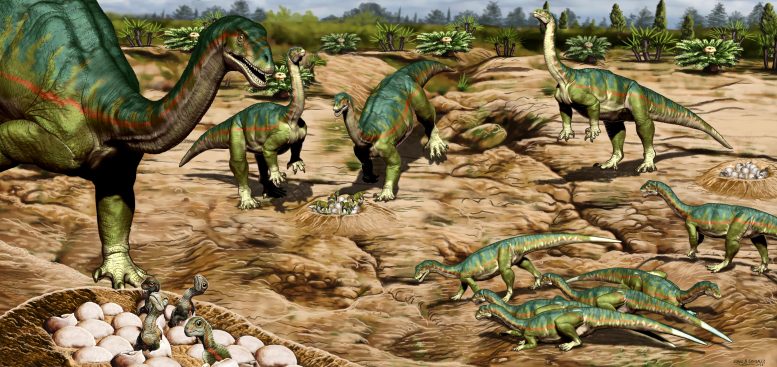 New research on a vast fossil site in Patagonia shows that some of the earliest dinosaurs, the Mussaurus patagonicus, lived in herds and suggests that this behavior may have been one of the keys to the success of dinosaurs. Credit: Jorge Gonzalez
New research on a vast fossil site in Patagonia shows that some of the earliest dinosaurs, the Mussaurus patagonicus, lived in herds and suggests that this behavior may have been one of the keys to the success of dinosaurs. Credit: Jorge Gonzalez
Using X-ray tomography imaging, they were able to examine the eggs’ contents without breaking them apart, and discovered preserved embryos within, which they used to confirm that the fossils were all members of Mussaurus patagonicus — a plant-eating dinosaur that lived in the early Jurassic period and is classified as a sauropodomorph, a predecessor of the massive, long-necked sauropods that later roamed the Earth.
Surprisingly, the researchers observed that the fossils were grouped by age: Dinosaur eggs and hatchlings were found in one area, while skeletons of juveniles were grouped in a nearby location. Meanwhile, remains of adult dinosaurs were found alone or in pairs throughout the field site.
<iframe loading="lazy" title="Earliest evidence of herd‐living and age segregation amongst dinosaurs" width="777" height="437" src="https://www.youtube.com/embed/JA-RgTZKmQ8?feature=oembed" frameborder="0" allow="accelerometer; autoplay; clipboard-write; encrypted-media; gyroscope; picture-in-picture" allowfullscreen="" style="margin: 0px; padding: 0px; border-width: 0px; border-style: initial; font: inherit; vertical-align: baseline; max-width: 100%;"></iframe>
From CONICET Documental: “Earliest evidence of herd-living and age segregation amongst dinosaurs.”
This “age segregation,” the researchers believe, is a strong sign of a complex, herd-like social structure. The dinosaurs likely worked as a community, laying their eggs in a common nesting ground. Juveniles congregated in “schools,” while adults roamed and foraged for the herd.
“This may mean that the young were not following their parents in a small family structure,” says team member Jahandar Ramezani, a research scientist in MIT’s Department of Earth, Atmospheric and Planetary Sciences. “There’s a larger community structure, where adults shared and took part in raising the whole community.”
Ramezani dated ancient sediments among the fossils and determined that the dinosaur herd dates back to around 193 million years ago, during the early Jurassic period. The team’s results represent the earliest evidence of social herding among dinosaurs.
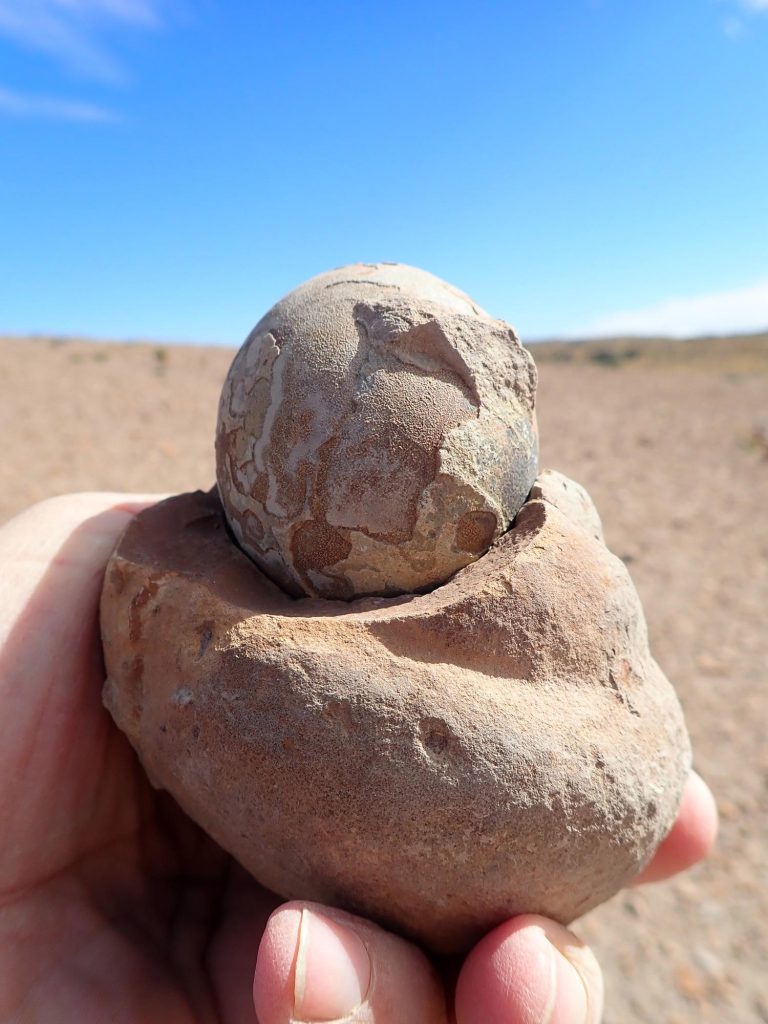 Paleontologists in Argentina unearthed a community of dinosaurs in Patagonia, including a nest of chicken-sized eggs, such as the one shown here. Credit: Roger Smith
Paleontologists in Argentina unearthed a community of dinosaurs in Patagonia, including a nest of chicken-sized eggs, such as the one shown here. Credit: Roger Smith
Living in herds may have given Mussaurus and other social sauropodomorphs an evolutionary advantage. These early dinosaurs originated in the late Triassic, shortly before an extinction event wiped out many other animals. For whatever reason, sauropodomorphs held on and eventually dominated the terrestrial ecosystem in the early Jurassic.
“We’ve now observed and documented this earliest social behavior in dinosaurs,” Ramezani says. “This raises the question now of whether living in a herd may have had a major role in dinosaurs’ early evolutionary success. This gives us some clues to how dinosaurs evolved.”
Early herding
Since 2013, paleontologists on the team have worked in the Laguna Colorada Formation, a site in southern Patagonia that is known for bearing fossils of early sauropodomorphs. When scientists first discovered fossils within this formation in the 1970s, they named them Mussaurus for “mouse lizard,” as they assumed the skeletons were of miniature dinosaurs.
Only much later did scientists, including members of the Argentinian team, discover bigger skeletons, indicating Mussaurus adults were much larger than their rodent namesakes. The name stuck, however, and the team has continued to unearth a rich collection of Mussaurus fossils from a small, square kilometer of the formation.
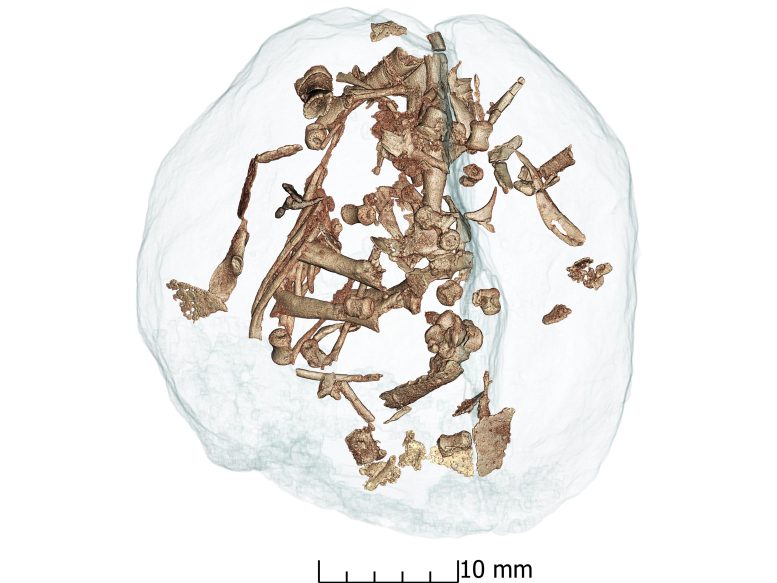 Using X-ray imaging, the scientists scanned eggs to discover preserved embryo skeletons, which they used to confirm the fossils as members of the plant-eating dinosaur, Mussaurus patagonicus. Credit: Vincent Fernandez
Using X-ray imaging, the scientists scanned eggs to discover preserved embryo skeletons, which they used to confirm the fossils as members of the plant-eating dinosaur, Mussaurus patagonicus. Credit: Vincent Fernandez
The fossils they have identified so far were found in three sedimentary layers spaced close together, indicating that the region may have been a common breeding ground where the dinosaurs returned regularly, perhaps to take advantage of favorable seasonal conditions.
Among the fossils they uncovered, the team discovered a group of 11 articulated juvenile skeletons, intertwined and overlapping each other, as if they had been suddenly thrown together. In fact, judging from the remarkably preserved nature of the entire collection, the team believes this particular herd of Mussaurus died “synchronously,” perhaps quickly buried by sediments.
Based on evidence of ancient flora in the nearby outcrops, the Laguna Colorada Formation has long been assumed to be relatively old on the dinosaur timescale. The team wondered: Could these dinosaurs have been herding from early on?
“People already knew that in the late Jurassic and Cretaceous, the large herbivore dinosaurs exhibited social behavior — they lived in herds and had nesting spots,” Ramezani says. “But the question has always been, when was the earliest time for such herding behavior?”
A gregarious line
To find out, Diego Pol, a paleontologist at the Egidio Feruglio Paleontological Museum in Argentina who led the study, looked for samples of volcanic ash among the fossils to send to Ramezani’s lab at MIT. Volcanic ash can contain zircon — mineral grains contaning uranium and lead, the isotopic ratios of which Ramezani can precisely measure. Based on uranium’s half-life, or the time it takes for half of the element to decay into lead, he can calculate the age of the zircon and the ash in which it was found. Ramezani successfully identified zircons in two ash samples, all of which he dated to around 193 million years old.
Since the volcanic ash was found in the same sediment layers as the fossils, Ramezani’s analyses strongly suggest that the dinosaurs were buried at the same time the ash was deposited. A likely scenario may have involved drought and wind-blown dust that starved and rapidly buried the herd, while ash from a distant eruption happened to drift over and, luckily for science, deposit zircons in the sediments.
<iframe loading="lazy" title="Mussaurus patagonicus Dinosaur Egg CT Scan" width="777" height="583" src="https://www.youtube.com/embed/X6Of-6XKqeQ?feature=oembed" frameborder="0" allow="accelerometer; autoplay; clipboard-write; encrypted-media; gyroscope; picture-in-picture" allowfullscreen="" style="margin: 0px; padding: 0px; border-width: 0px; border-style: initial; font: inherit; vertical-align: baseline; max-width: 100%;"></iframe>
The team of scientists used high-energy X-rays at the European Synchrotron (ESRF) to penetrate the dinosaur eggs without destroying them and get a full view inside them. Credit: Vincent Fernandez/Diego Pol/ESRF
Taken together, the team’s results show that Mussaurus and possibly other dinosaurs evolved to live in complex social herds as early as 193 million years ago, around the dawn of the Jurassic period.
“Evidence suggests that Mussaurus optimized foraging potentials during the early Jurassic via age-based social partitioning — neonates, juveniles, and adults apparently foraged, and perished, in age-based groups,” says Raymond Rogers, a professor of geology at Macalester College, who was not involved in the study. “This type of gregarious behavior is common today in large terrestrial herbivores. It is amazing to see clear evidence of the same phenomenon in this early dinosaur species.”
Scientists suspect that two other types of early dinosaurs — Massospondylus from South Africa and Lufengosaurus from China — also lived in herds around the same time, although the dating for these dinosaurs has been less precise. If multiple separate lines of dinosaurs lived in herds, the researchers believe the social behavior may have evolved earlier, perhaps as far back as their common ancestor, in the late Triassic.
“Now we know herding was going on 193 million years ago,” Ramezani says. “This is the earliest confirmed evidence of gregarious behavior in dinosaurs. But paleontological understanding says, if you find social behavior in this type of dinosaur at this time, it must have originated earlier.”
Reference: “Earliest evidence of herd-living and age segregation amongst dinosaurs” by Diego Pol, Adriana C. Mancuso, Roger M. H. Smith, Claudia A. Marsicano, Jahandar Ramezani, Ignacio A. Cerda, Alejandro Otero and Vincent Fernandez, 21 October 2021, Scientific Reports.
DOI: 10.1038/s41598-021-99176-1
This research was supported, in part, by National Science Foundation in the U.S. and the National Scientific and Technical Research Council of Argentina.
We have invented the world; WE see
-
10-22-2021, 08:46 AM #56
LMAO .. If the idiots that bought that garbage would step up and admit it's junk , less people would waste their hard earned money on that crud. Then less of it would be imported ... trickle up effect.

---------------------------------------------------------------------------------------------
The V.I. quips : Your wrong on all counts...
Then copy's and pastes another waste of space that states from the beginning ... IS ABOUT TO , which to any of us mean's HASEN'T HAPPENED YET ..
Carbon dating, the archaeological workhorse, is getting a major reboot
A long-anticipated recalibration of radiocarbon dating could shift the age of some prehistoric samples hundreds of years
For the first time in seven years, the technique is due to be recalibrated using a slew of new data from around the world..
So little jimmie :
What does the left wing narrative , cartoons for dummies , presented not as fact but hearsay .. in a case where something hasn't been fixed yet. You really should read and learn to comprehend , before you post.
You owe me , bassin as well as the group an apology .. now let's see what your time stamp says your made of . That action would "date" the level of maturity you possess .. !
<body id="cke_pastebin" style="position: absolute; top: 288px; width: 1px; height: 1px; overflow: hidden; left: -1000px;">Radiocarbon dating — a key tool used for determining the age of prehistoric samples — is about to get a major update. For the first time in seven years, the technique is due to be recalibrated using a slew of new data from around the world.</body>
Similar Threads
-
California Custom Boats or California Taylor's
By Karsten in forum General Boating DiscussionReplies: 37Last Post: 10-05-2020, 10:43 AM -
jacks small engines
By Quinten in forum The Scream And Fly LoungeReplies: 10Last Post: 08-04-2014, 10:47 PM -
Small 15" shaft engines ?
By Adam Younger in forum Four Stroke and Direct Injected Two Stroke EnginesReplies: 3Last Post: 05-21-2013, 07:48 AM -
mods to small engines (40 horse)
By jbert22 in forum Technical DiscussionReplies: 4Last Post: 08-11-2012, 05:13 PM -
Anyone know small frame Tecumseh engines well?
By Riverman in forum Technical DiscussionReplies: 15Last Post: 01-23-2008, 01:48 PM



 Thanks:
Thanks:  Likes:
Likes: 




 Reply With Quote
Reply With Quote










